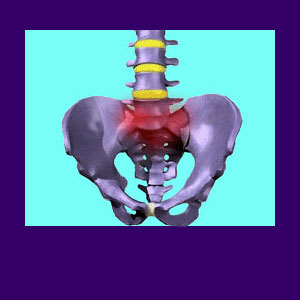
Does sacralization cause back pain? This is a common question for people who are affected by congenital or developed natural vertebral fusions at the lumbosacral juncture. For many years, sacralized vertebrae were deemed to be problematic and often even pathological. There was never any evidence to support this arbitrary medical opinion and now there is considerable evidence to repute it.
Sacralization, also known as sacralized vertebrae, describes a scenario when the lowest lumbar vertebral level fuses with the upper end of the sacrum, forming one large piece of bone. Most often this organic fusion occurs at L5, which is the final lumbar level in the typical human anatomy. However, it can occur at L6, when an extra lumbar vertebra is present and can also take place at a transitional vertebral level which demonstrates characteristics of both lumbar and sacral bone structure.
This essay explores the research evidence demonstrating that the vast majority of sacralization conditions are completely innocent of causing any type of pain or neurological dysfunction whatsoever. We will also detail the possible underlying reasons why pain does exist in some patients with sacralized vertebral bones.
Does Sacralization Cause Back Pain? / The Facts
When a lumbar vertebra becomes sacralized, it is said to have naturally fused to the sacrum, becoming one solid mass of bone. This can occur as a congenital abnormality, a developmental abnormality, a result of traumatic injury or a result of normal spinal degenerative processes.
It is possible, under extremely rare occasions, for patients to suffer 2 sacralized lumbar vertebrae, at L5 and L4, although this is virtually never seen.
Sacralized vertebral bones can be easily diagnosed via spinal x-ray or other advanced form of imaging, such as spinal MRI.
Statistics show a large number of people who have sacralized vertebrae also experience lower back pain. However, one must account for the simple truth that a large number of people without sacralized vertebrae also have identical expressions of lower back pain.
Why should the joined vertebrae accept blame, without any evidence of a pathological component to the organic lumbosacral fusion?
Does Sacralization Cause Back Pain? / Explanations
Just because a lumbar vertebrae has fused with the sacrum does not mean that back pain is imminent. In fact, the vast majority of congenital and developmental sacralized conditions are asymptomatic and are not the source of any pain at all.
In many patients, their lower back pain and sciatica are mistakenly blamed on completely innocent sacralized vertebrae, when all along the symptoms are the direct result of another anatomical, disease-related or ischemic source. In these cases, the sacralized section of backbone acts as nothing more than a scapegoat to justify unneeded and ineffective treatment. However, this does not mean that other spinal and non-spinal causations can not cause the same types of common pain syndromes that exist in people with typical, non-sacralized anatomies. In essence, sacralization might not cause pain, but it does not save the patients from experiencing pain from other usual sources. It is simply a coincidental non-factor in most instances.
There are a few circumstances where sacralization itself might be part of the pain problem. Usually, these cases revolve around patients who developed rather sudden organic vertebral fusions following severe traumatic lower back injury. In many of these specific parameter cases, the vertebrae may not have joined at the proper angle to ensure a patent central canal or patent foraminal openings for exiting nerve roots. In some cases, sacralized segments can impinge on spinal nerve roots or the cauda equina structure, but this is rare. MRI technology should be able to accurately diagnose potential sources of structural pain based on neurological canal stenosis.
Does Sacralization Cause Back Pain? / Answers
If you have been diagnosed as having back pain due to a fused lower lumbar vertebra, be very careful and be sure to demand that a specialist take a look at the MRI films. Simply proceeding with surgical treatment can force a patient to endure unnecessary suffering, and even escalated symptoms, which may become impossible to resolve if an operation is performed. Curative statistics for using surgical treatment to resolve pain blamed directly on sacralization are very poor.
If there is a verified structural reason for the pain, appropriate minimally invasive surgery should be able to correct it. If the pain continues after the procedure, it is usually safe to consider the very real chance that the condition was misdiagnosed as the symptomatic source the entire time. Unfortunately, this happens in a great number of back pain sufferers. It is always better achieve an accurate and correct diagnosis before even considering invasive care practices for any suspected source of back pain.
Our research has shown that the overwhelming majority of sacralized vertebrae are not painful or problematic. That being said, we still see the great diversity of other possible causes of pain exist in many of these patients, including disc irregularities, spinal curvature concerns, osteoarthritic changes, muscular pain syndromes, and of course, mindbody disorders. As a final comment, we must mention that the last type of pain, the psychogenic variety, might actually have a direct link to sacralization. This is not due to any pathological component of the structural change itself, but instead is a direct result of the diagnostic nocebo effect; wherein the patient perceives that they are damaged and therefore suffers pain based on psychological programming. Luckily, many of these patients have proven this point soundly by recovering from their symptoms using purely psychoemotional treatment, such as that offered by knowledge therapy.




